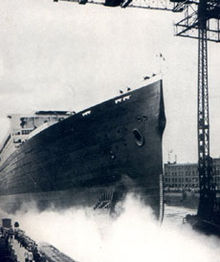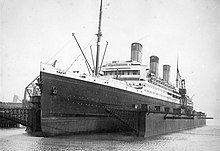Majestic (ship, 1922)
|
The Majestic (postcard, ca.1922)
|
||||||||||||||||
|
||||||||||||||||
|
||||||||||||||||
|
||||||||||||||||
The RMS Majestic was a ship of the White Star Line . It was originally built for HAPAG under the name Bismarck .
Ship life
As Bismarck
The Bismarck was the third of the three largest luxury liners ever built for HAPAG and Germany. She was of the Imperator class . The experience gained with the two predecessors was incorporated into the Bismarck , although its completion was considerably delayed because of the war that had meanwhile broken out. The ship was built by Blohm & Voss and launched on June 20, 1914 . The Kaiser, who was personally present at the launch, accidentally took over the baptism. Hannah von Bismarck, a granddaughter of the first Reich Chancellor, was to christen the ship. However, she swung the bottle too late and missed the ship. With presence of mind, Wilhelm II snatched the bottle from her and hit it before the body was out of reach. After that, work on the ship was suspended until long after the end of the war. After the war, the reparations committee awarded the imperator (at the request of Kaiser Wilhelm II the male article was used for the ship ) and the still unfinished Bismarck to the British.
As Majestic
In 1921, Cunard and the White Star Line jointly bought both ships. The Bismarck now became the Majestic of the White Star Line, although the 50 percent share in the respective other ship remained in place for another ten years. So Cunard owned half of the Majestic and the White Star Line owned half of the RMS Berengaria .
First the ship had to be completed. That happened at the Hamburg shipyard Blohm & Voss . After completion, the ship left Hamburg on March 28, 1922 for a test drive in the North Sea . On the way down the Elbe, the ship got stuck in the silt for a short time, but could be towed free and reached Cuxhaven , where it was anchored in the roadstead . In the tests on the high seas, the ship is said to have been over 25 knots , but most tests were carried out at lower speeds before the ship left on May 10, 1922 on its maiden voyage to New York .
The Majestic was the largest of the three White Star Line ships in the North Atlantic. The other two were the RMS Olympic and the Homeric . The Majestic had been in service on this route for the next ten years. Together with the Cunard ships RMS Mauretania , RMS Berengaria and RMS Aquitania , weekly departures could be offered. The Majestic was the second fastest ship of this sextet : the Mauretania was even faster and was able to navigate the North Atlantic at an average speed of 24 knots.
Towards the end of the 1920s, the Majestic occasionally went on cruises and made short trips between Atlantic crossings. B. from New York to Halifax and back.
Despite the global economic crisis in the early 1930s, the express service across the Atlantic was initially retained. The service had now been cut to the four ships Aquitania , Berengaria , Olympic and Majestic . The Homeric and the Mauretania went on cruises during this time . In 1934, the Majestic was hit by a monster wave in the North Atlantic , with her captain seriously injured on the bridge (usually about 30 m above the waterline). Until Normandy was commissioned in 1935, the Majestic was the largest ship in the world.
With the merger of Cunard and White Star Line to form Cunard-White Star Ltd. in 1934 the era of the shipping group's large passenger ships slowly came to an end. The North Atlantic Service was hit very hard by the aftermath of the global economic crisis. The Olympic was decommissioned in 1935. The same thing happened to the Majestic in 1936 after completing her 207th round trip. On May 15, 1936, it was sold for demolition, but could be saved from the cutting torches again because the naval management bought the ship from the scrapping yard and had it converted into a training ship for 2,000 marines under the name HMS Caledonia .
The British Navy had thus received its largest training ship of all time. The large lounges were converted into lecture halls, workshops were set up and guns were installed. Masts and smokestacks were shortened to allow the ship to enter the Scottish region of Fife . There she arrived in Rosyth on April 23, 1937 .
The old ship performed this task for two years until war broke out. The students were housed ashore, the ship was towed out onto the Firth of Forth and anchored there. There were new plans for the ship, which should possibly be converted into a troop transport , but were destroyed on September 29, 1939 by a fire on board. So much fire fighting water was pumped into the ship that it sank and was declared a total loss. In March 1940 it was sold again to the Thomas T. Ward scrapping company and some of it was scrapped on the spot. The rest was towed on to Inverkeithing , also in Fife east of Rosyth , for final demolition.
Sister ships
- Imperator (later Berengaria )
- Fatherland (later Leviathan )
literature
- Robert D. Ballard , Ken Marschall : Lost Liners - From the Titanic to Andrea Doria - the glory and decline of the great luxury liners. Translated from the English by Helmut Gerstberger. Heyne, Munich 1997, ISBN 3-453-12905-9 .
- John Maxtone-Graham: The way across the Atlantic. The only connection between Europe and America. The golden era of the great luxury liners. (= Heyne-Bücher, Volume 19 / Heyne-Sachbuch, Volume 741). Heyne Verlag, Munich 2000, ISBN 3-453-18093-3 .
- Clas Broder Hansen: The German Passenger Ships 1816–1990. Urbes Verlag, Graefelfing 1990, ISBN 3-924896-19-4 .
- Arnold Kludas : The German express steamers. The imperator class - the climax of an era. In: Deutsches Schiffahrtsarchiv, Volume 8. Kabel, Hamburg 1985, ISSN 0343-3668 , pp. 147-164 ( PDF ).
- Arnold Kludas: The History of German Passenger Shipping. Volume 4: Destruction and rebirth 1914 to 1930 (= writings of the German Maritime Museum, Volume 21). Ernst Kabel Verlag, Hamburg 1989, ISBN 3-8225-0047-X .
- Eberhard Mertens (ed.): The Hapag giants of the Imperator class. The history of the luxury ships Imperator, Vaterland, Bismarck in pictures and contemporary documents. Olms, Hildesheim 1974, ISBN 3-487-08083-4 .
- Hans Jürgen Witthöft: Ballin's thick steamers - Imperator, Fatherland, Bismarck. Koehler, Herford 1974, ISBN 3-7822-0100-0 .
- Peter Zerbe: The big German passenger ships "Imperator", "Vaterland", "Bismarck". Nautik Historie Verlag, Hamburg 1999, ISBN 3-929231-11-5 .
Web links
- Bismarck / RMS Majestic . In: AtlanticLiners.com (English)
- Bismarck / RMS Majestic . In: GreatShips.net (English)
- Ship without luck - the "Bismarck" was launched 85 years ago . In: Welt.de , June 19, 1999
Notes and individual references
- ↑ see also: seaman's culture / ship names


